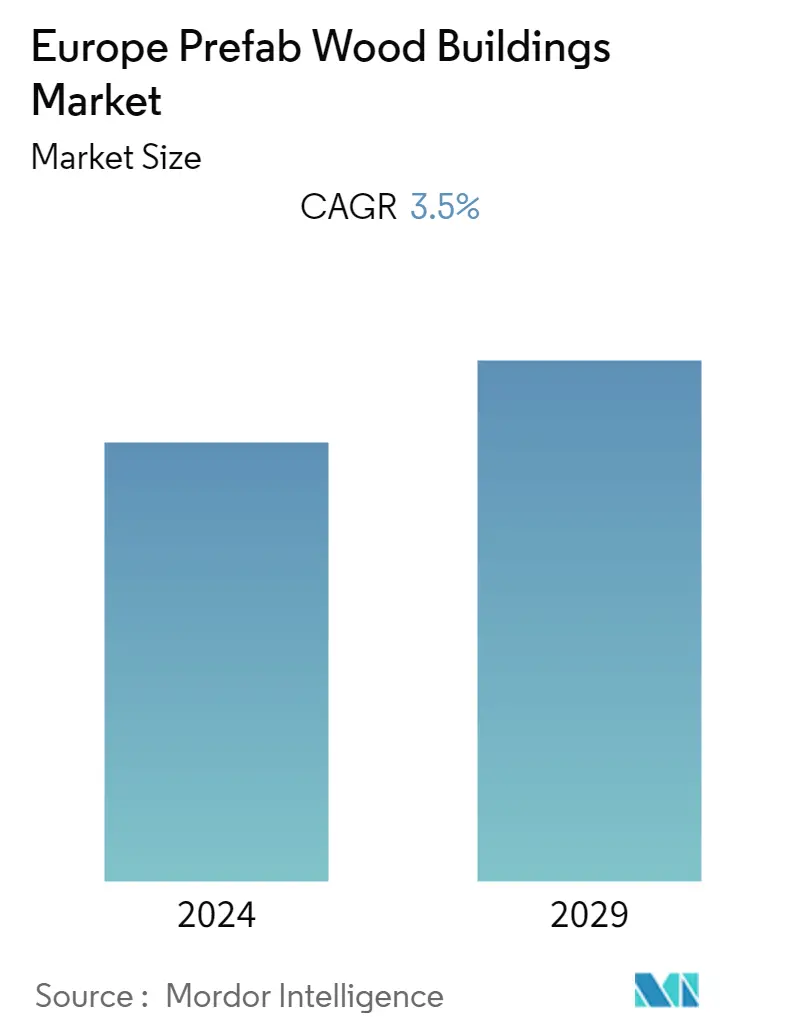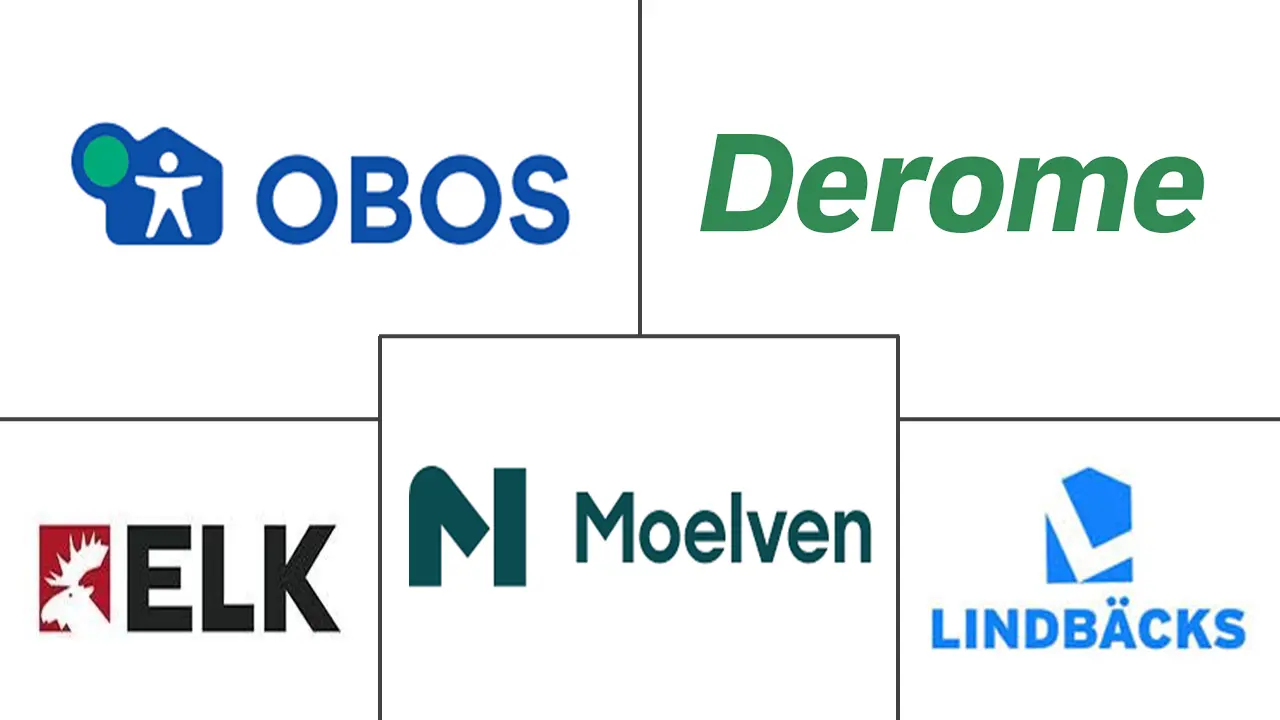Market Size of Europe Prefab Wood Buildings Industry

| Study Period | 2020 - 2029 |
| Base Year For Estimation | 2023 |
| Forecast Data Period | 2024 - 2029 |
| Historical Data Period | 2020 - 2022 |
| CAGR | 3.50 % |
| Market Concentration | Medium |
Major Players
*Disclaimer: Major Players sorted in no particular order |
Europe Prefab Wood Buildings Market Analysis
- The European Prefabricated Wood Buildings Market is valued at about USD 17.5 billion and is expected to register a CAGR of more than 3.5% during the forecast period. The outbreak of the COVID-19 pandemic has led to severe uncertainty for vendors and contractors in the construction industry across Europe. Several construction companies shut down their projects due to lockdowns and restrictions. However, due to immediate requirements for hospitals and quarantine sectors, the demand for prefabricated materials witnessed an increase. Since a high workforce is required for traditional construction, opting for prefabricated buildings became an optimum solution during the pandemic.
- The industry for prefabricated construction is anticipated to benefit greatly from the usage of additive manufacturing in Europe. Eco-friendly manufacturing processes and materials are used by businesses to set their products apart from their rivals.
- The emphasis on energy efficiency has prompted the use of materials that absorb energy, including micro houses. Another important factor fueling market expansion in the region, particularly in Switzerland, the Nordic countries and others, is the introduction of turnkey solutions. Europe's prefabricated building sector is dominated by Germany, the Nordic region.
- Since humans have been using wood for thousands of years, wooden architecture is now made easier by digital manufacturing and computational design technologies. This makes it possible for architects and engineers to create ever more intricate and effective timber structures.
- According to research from Sweden, wood structures are 16% less expensive than concrete ones, and because of their light weight and increased precision, they may be built up to 20% faster.
- In addition, compared to steel and concrete, the production and construction of wood frames generate 40% less waste: Steel buildings (which often have concrete floors) normally have a mass of about 160kg/m3, whereas concrete buildings typically have a bulk density of around 300kg/m3, and a timber building with timber flooring may have a mass of only a little over 70kg/m3 which could be assembled onsite effortlessly.
Europe Prefab Wood Buildings Industry Segmentation
A prefabricated building is a building or part of a building that has been manufactured in advance and can be easily transported and assembled.
The European prefabricated buildings market covers growing trends and projects like commercial, residential, and industrial construction. The market scope has been extended to provide insights at the regional level by segmenting across geography. Along with the report's scope, it also analyzes the key players and the competitive landscape in the market. The impact of COVID-19 has also been incorporated and considered during the study.
The Europe Prefab Wood Building Market is segmented By Panel Systems (Cross-laminated timber (CLT) panels, Nail-laminated timber (NLT) panels, Dowel-laminated timber (DLT) panels, and Glue-laminated timber (GLT) columns and beams), By Application (Single Family Residential, Multi-family Residential, Office, Hospitality, and Others) and By Geography (Belgium, Finland, France, Germany, Italy, Russia, Spain, Sweden, United Kingdom, and Rest Of Europe). The report offers market size and forecasts for The Europe Prefab Wood Building Market in value (USD Billion) for all the above segments.
| By Application | |
| Residential (Single Family Residential, Multi-family Residential) | |
| Commercial (Office, Hospitality, etc.) | |
| Other Applications (Infrastructure and Industrial) |
| By Panel Systems | |
| Cross-Laminated Timber (CLT) Panels | |
| Nail-Laminated Timber (NLT) Panels | |
| Dowel-Laminated Timber (DLT) Panels | |
| Glue-Laminated Timber (GLT) Columns and Beams |
| By Geography | |
| Belgium | |
| Finland | |
| France | |
| Germany | |
| Italy | |
| Russia | |
| Spain | |
| Sweden | |
| United Kingdom | |
| Rest Of Europe |
Europe Prefab Wood Buildings Market Size Summary
The European prefabricated wood buildings market is experiencing a notable transformation, driven by the increasing adoption of modular construction and the integration of advanced technologies like additive manufacturing. This shift is largely attributed to the need for efficient and sustainable building solutions, especially in the wake of the COVID-19 pandemic, which highlighted the advantages of prefabricated structures in terms of reduced labor requirements and faster construction times. The market is characterized by a focus on eco-friendly materials and energy-efficient designs, with countries like Germany and the Nordic region leading the charge. The use of digital manufacturing and computational design has further enhanced the capabilities of wooden architecture, making it a competitive alternative to traditional materials like concrete and steel.
The market is poised for growth, fueled by significant infrastructure projects in regions such as Ukraine and Turkey, where rebuilding efforts are expected to create substantial demand for prefabricated solutions. The UK's housing sector is also witnessing a surge in modular construction, driven by the need for affordable housing and the challenges faced by small-to-medium-sized builders in securing financing. This trend is supported by government initiatives and investments aimed at stimulating residential construction. The competitive landscape of the market is moderately fragmented, with key players like OBOS Bostadsutveckling AB and Derome Husproduktion AB actively participating in the market. Strategic acquisitions and investments, such as Ardmac's purchase of Cental and HusCompagniet's acquisition of a prefabricated factory, are expected to further enhance the market's growth prospects by streamlining production processes and expanding capabilities.
Europe Prefab Wood Buildings Market Size - Table of Contents
-
1. MARKET INSIGHTS & DYNAMICS
-
1.1 Market Overview
-
1.2 Market Dynamics
-
1.2.1 Market Drivers
-
1.2.2 Market Restraints
-
1.2.3 Opportunities
-
-
1.3 Industry Attractiveness - Porter's Five Forces Analysis
-
1.3.1 Threat of New Entrants
-
1.3.2 Bargaining Power of Buyers/Consumers
-
1.3.3 Bargaining Power of Suppliers
-
1.3.4 Threat of Substitute Products
-
1.3.5 Intensity of Competitive Rivalry
-
-
1.4 Industry Supply Chain / Value Chain Analysis
-
1.5 Technological Innovations in the Market
-
1.6 Government Regulations and Initiatives in the Industry
-
1.7 Insights into Rental Yields in the Segment
-
1.8 Cost Structure Analysis of the Prefabricated Buildings Industry
-
1.9 Brief on Different Structures Used in the Prefabricated Buildings Industry
-
1.10 Impact of the COVID-19 on the Market
-
-
2. MARKET SEGMENTATION
-
2.1 By Application
-
2.1.1 Residential (Single Family Residential, Multi-family Residential)
-
2.1.2 Commercial (Office, Hospitality, etc.)
-
2.1.3 Other Applications (Infrastructure and Industrial)
-
-
2.2 By Panel Systems
-
2.2.1 Cross-Laminated Timber (CLT) Panels
-
2.2.2 Nail-Laminated Timber (NLT) Panels
-
2.2.3 Dowel-Laminated Timber (DLT) Panels
-
2.2.4 Glue-Laminated Timber (GLT) Columns and Beams
-
-
2.3 By Geography
-
2.3.1 Belgium
-
2.3.2 Finland
-
2.3.3 France
-
2.3.4 Germany
-
2.3.5 Italy
-
2.3.6 Russia
-
2.3.7 Spain
-
2.3.8 Sweden
-
2.3.9 United Kingdom
-
2.3.10 Rest Of Europe
-
-
Europe Prefab Wood Buildings Market Size FAQs
What is the current Europe Prefab Wood Buildings Market size?
The Europe Prefab Wood Buildings Market is projected to register a CAGR of 3.5% during the forecast period (2024-2029)
Who are the key players in Europe Prefab Wood Buildings Market?
OBOS Bostadsutveckling AB, Derome Husproduktion AB, Lindbacks Bygg AB, Moelven Byggmodul AB and ELK Fertighaus GmbH Zweigniederlassung Dtl. are the major companies operating in the Europe Prefab Wood Buildings Market.

